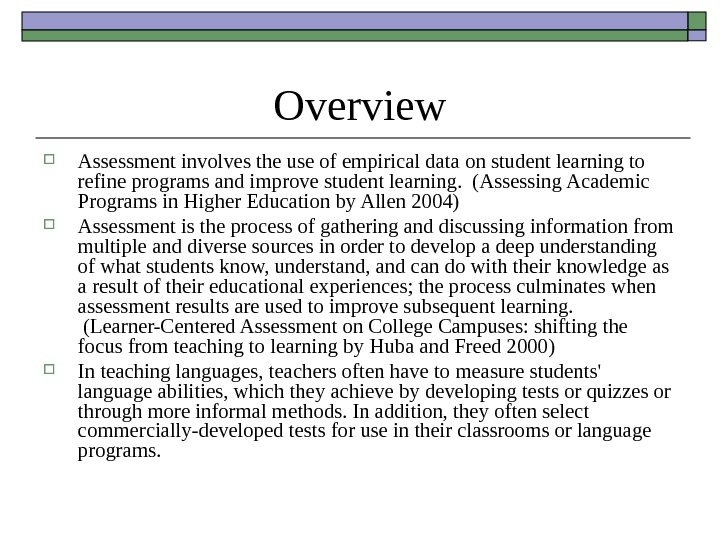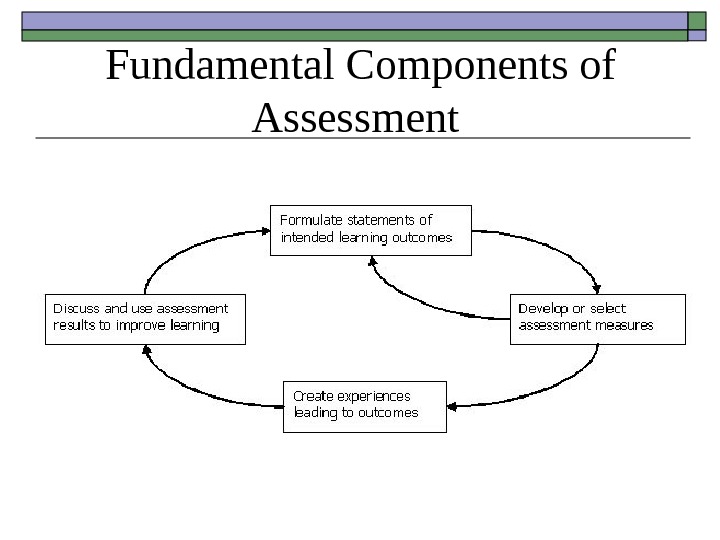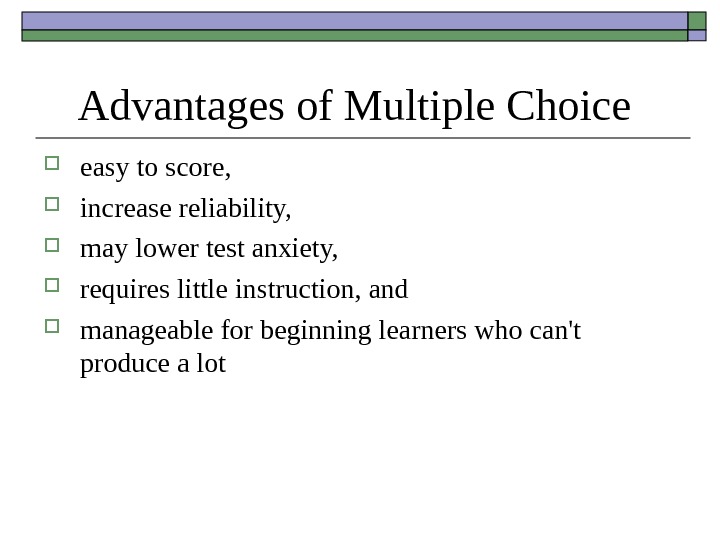Assessment in FLT Done by: Zhaisanbayeva Assem
















assessment_in_flt_zhaisanbayeva_assem.ppt
- Размер: 128.5 Кб
- Количество слайдов: 15
Описание презентации Assessment in FLT Done by: Zhaisanbayeva Assem по слайдам
 Assessment in FLT Done by: Zhaisanbayeva Assem 401 -group
Assessment in FLT Done by: Zhaisanbayeva Assem 401 -group
 Plan: Overview A taxonomy of approaches to assessment Fundamental Components of Assessment Direct assessment: advantages and disadvatages Indirect assesment: Multiple choice. Advantages and disadvantages Key ideas in assessment References
Plan: Overview A taxonomy of approaches to assessment Fundamental Components of Assessment Direct assessment: advantages and disadvatages Indirect assesment: Multiple choice. Advantages and disadvantages Key ideas in assessment References
 Overview Assessment involves the use of empirical data on student learning to refine programs and improve student learning. (Assessing Academic Programs in Higher Education by Allen 2004) Assessment is the process of gathering and discussing information from multiple and diverse sources in order to develop a deep understanding of what students know, understand, and can do with their knowledge as a result of their educational experiences; the process culminates when assessment results are used to improve subsequent learning. (Learner-Centered Assessment on College Campuses: shifting the focus from teaching to learning by Huba and Freed 2000) In teaching languages, teachers often have to measure students’ language abilities, which they achieve by developing tests or quizzes or through more informal methods. In addition, they often select commercially-developed tests for use in their classrooms or language programs.
Overview Assessment involves the use of empirical data on student learning to refine programs and improve student learning. (Assessing Academic Programs in Higher Education by Allen 2004) Assessment is the process of gathering and discussing information from multiple and diverse sources in order to develop a deep understanding of what students know, understand, and can do with their knowledge as a result of their educational experiences; the process culminates when assessment results are used to improve subsequent learning. (Learner-Centered Assessment on College Campuses: shifting the focus from teaching to learning by Huba and Freed 2000) In teaching languages, teachers often have to measure students’ language abilities, which they achieve by developing tests or quizzes or through more informal methods. In addition, they often select commercially-developed tests for use in their classrooms or language programs.
 A Taxonomy of Approaches to Assessment
A Taxonomy of Approaches to Assessment
 Fundamental Components of Assessment
Fundamental Components of Assessment
 Formulating Statements of Intended Learning Outcomes – statements describing intentions about what students should know, understand, and be able to do with their knowledge when they graduate. Developing or Selecting Assessment Measures – designing or selecting data gathering measures to assess whether or not our intended learning outcomes have been achieved. Includes Direct assessments – projects, products, papers/theses, exhibitions, performances, case studies, clinical evaluations, portfolios, interviews, and oral exams – which ask students to demonstrate what they know or can do with their knowledge. Indirect assessments – self-report measures such as surveys – in which respondents share their perceptions about what graduates know or can do with their knowledge. Creating Experiences Leading to Outcomes – ensuring that students have experiences both in and outside their courses that help them achieve the intended learning outcomes. Discussing and Using Assessment Results to Improve Teaching and Learning – using the results to improve individual student performance.
Formulating Statements of Intended Learning Outcomes – statements describing intentions about what students should know, understand, and be able to do with their knowledge when they graduate. Developing or Selecting Assessment Measures – designing or selecting data gathering measures to assess whether or not our intended learning outcomes have been achieved. Includes Direct assessments – projects, products, papers/theses, exhibitions, performances, case studies, clinical evaluations, portfolios, interviews, and oral exams – which ask students to demonstrate what they know or can do with their knowledge. Indirect assessments – self-report measures such as surveys – in which respondents share their perceptions about what graduates know or can do with their knowledge. Creating Experiences Leading to Outcomes – ensuring that students have experiences both in and outside their courses that help them achieve the intended learning outcomes. Discussing and Using Assessment Results to Improve Teaching and Learning – using the results to improve individual student performance.
 Direct Assessment Direct assessment of language allows teachers to see students using language in context, through tasks that require performance of language. Direct assessment is often used in measuring speaking or writing. Examples of direct assessment might include presentations, interviews, writing summaries, or portfolios.
Direct Assessment Direct assessment of language allows teachers to see students using language in context, through tasks that require performance of language. Direct assessment is often used in measuring speaking or writing. Examples of direct assessment might include presentations, interviews, writing summaries, or portfolios.
 Advantages of Direct Assessment Direct assessment is often preferred for assessing language for a number of reasons: increased potential for communicative interaction, better evidence for language use, more motivating for students, and more authenticity.
Advantages of Direct Assessment Direct assessment is often preferred for assessing language for a number of reasons: increased potential for communicative interaction, better evidence for language use, more motivating for students, and more authenticity.
 Disadvantages of Direct Assessment Some problems with direct assessment include: performance anxiety, some inauthenticity in interview structure, time-consuming to conduct and score, and difficulty in finding the best method for scoring.
Disadvantages of Direct Assessment Some problems with direct assessment include: performance anxiety, some inauthenticity in interview structure, time-consuming to conduct and score, and difficulty in finding the best method for scoring.
 Indirect assessment: Multiple Choice Indirect assessment tries to assess the abilities that underlie the skills we are measuring and often uses items where the student selects a response, rather than constructing their own. One common kind of question used in indirect assessment is multiple-choice or binary questions (True/False)
Indirect assessment: Multiple Choice Indirect assessment tries to assess the abilities that underlie the skills we are measuring and often uses items where the student selects a response, rather than constructing their own. One common kind of question used in indirect assessment is multiple-choice or binary questions (True/False)
 Advantages of Multiple Choice easy to score, increase reliability, may lower test anxiety, requires little instruction, and manageable for beginning learners who can’t produce a lot
Advantages of Multiple Choice easy to score, increase reliability, may lower test anxiety, requires little instruction, and manageable for beginning learners who can’t produce a lot
 Disadvantages of Multiple Choice only assesses recognition of language, limited inferences about language possible, inauthentic to real language use, students can guess the answers, and writing successful multiple choice questions is difficult.
Disadvantages of Multiple Choice only assesses recognition of language, limited inferences about language possible, inauthentic to real language use, students can guess the answers, and writing successful multiple choice questions is difficult.
 Key Ideas in Assessment for Learning (Af. L) is the idea that learners should be part of the assessment process. It includes building learner’s awareness of their progress in learning and encourages peer and self-assessment. Students may be asked to help design tests or the rubrics for scoring. They may also provide their classmates with suggestions and support. Assessment for Learning helps students evaluate their strengths and areas of needed improvement.
Key Ideas in Assessment for Learning (Af. L) is the idea that learners should be part of the assessment process. It includes building learner’s awareness of their progress in learning and encourages peer and self-assessment. Students may be asked to help design tests or the rubrics for scoring. They may also provide their classmates with suggestions and support. Assessment for Learning helps students evaluate their strengths and areas of needed improvement.
 In an article by Chappuis and Stiggins (2002), three key components of Assessment for Learning are discussed: Student involved assessment. Students are not passive in the assessment process but are engaged in developing the assessment, determining what a good performance entails, and learning to score through models provided by the teacher. Effective teacher feedback. Teachers are the models for students to learn what is important in their performance. So feedback should be clear, descriptive, and illustrated for students. Students need guidance in giving their peers feedback as well as in evaluating themselves. This goal is grounded in the teacher modeling effective feedback. The skills of self-assessment. Af. L should lead to self-directed learning, which requires learners evaluate themselves. This skill is not easy and requires guidance from the teacher. Students should be asked to think about their goals, their current ability, and how to work from one to the other. Feedback and self-assessment are critical parts of this process.
In an article by Chappuis and Stiggins (2002), three key components of Assessment for Learning are discussed: Student involved assessment. Students are not passive in the assessment process but are engaged in developing the assessment, determining what a good performance entails, and learning to score through models provided by the teacher. Effective teacher feedback. Teachers are the models for students to learn what is important in their performance. So feedback should be clear, descriptive, and illustrated for students. Students need guidance in giving their peers feedback as well as in evaluating themselves. This goal is grounded in the teacher modeling effective feedback. The skills of self-assessment. Af. L should lead to self-directed learning, which requires learners evaluate themselves. This skill is not easy and requires guidance from the teacher. Students should be asked to think about their goals, their current ability, and how to work from one to the other. Feedback and self-assessment are critical parts of this process.
 References http: //assessment. uconn. e du http: //coerll. utexas. edu/methods/modules/assessment
References http: //assessment. uconn. e du http: //coerll. utexas. edu/methods/modules/assessment

